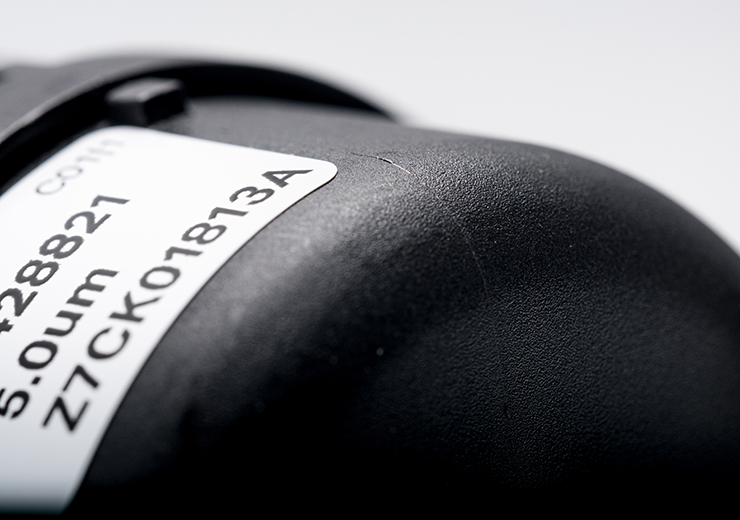Labels for the labeling of low-energy surfaces
The labels for low-energy surfaces require special adhesives to warrant safe adherence. The low-energy surfaces have a low surface tension (below 37 mN/m). The high-energy surfaces have a high surface tension (38-2030 mN/m) accordingly.
The plastic surfaces with a low surface tension do not take on usual adhesives. These difficult surfaces include e.g. silicone (24 mN/m), natural rubber (25 mN/m), polypropylene (29 mN/m), polyethylene (31 mN/m) and polyester (32 mN/m). If you wet these surfaces with testing ink, a round drop is formed on the surface, this way the low surface energy can be determined, whereas on a high-energy surface the drop dissolves.
The main features of labels for low-energy surfaces
- Very high adhesive power of the labels on low-energy and formed substrates
- Very good adhesion on very structured or grained plastic surfaces
- Constant grip for varying plastic compositions
- Permanently dimensionally stable and flexible
- High abrasion resistance with suitable thermal transfer ribbons for the thermal transfer printing
- High resistance in the area of chemicals and solvents
- Suitable for standard-compliant labeling like e.g. UL/CSA, FMVSS etc.
- Optimization of the processes by automation of material- and product flow and mechanical processing
- Additional safety functions like e.g. security cut-outs possible
- Numerous special materials by Avery, 3M, Flexcon, and Tesa available from stock
- Plain labels in individual formats and special forms
Functions and advantages – precisely tailored to your requirements for the labeling
The labels adhere safely on most plastics and coated metals. A preparatory treatment with primers or by sanding is not necessary. They adapt to rough and uneven structures like powder coated lacquers and are perfectly suitable for indoors and outdoors. Also on the plastic mixtures like e.g. reinforced or filled PP or PA, which will be increasingly applied in the production of injection molding components, an extraordinary high adhesion is shown.
The labels offer the best possible flexibility and will be adjusted individually to the customer’s requirements. This happens by using suitable special materials of leading manufacturers, individual die-cutting forms and premium adhesives.
The labels can be inscribed directly as required in variable amounts with current data at the site, by that the storage and the management of numerous labels may be partially dropped.
Some materials and products to be labeled are still hot when the labels must be adhered. In addition, other products can have a very rough or dusty or oily surface, which can be safely labeled with matching adhesives.
Our upscale and accurate processing with most modern die-cutting technologies guarantees the highest precision and reliability for the label application. Thus even labels with adhesives which are difficult to process can be processed mechanically very well, which increases the user efficiency in the long term.
Frequently Asked Questions
Industrial applications of labels for low-energy surfaces
The typical labeling products in the area of tag labels are barcode labels, type plates, rating plates, caution- and warning labels. They will be used inter alia for the labeling of plastic parts and -cases, assemblies, kegs, frames, covers, and injection molding components in the following branches and areas:
- Electronic industry
- Mechanical engineering
- Electric tools engineering
- Car manufacturing
- Vehicle construction
- Medical products
- Chemical industry
Individual features of labels for low-energy surfaces
Also material compounds, adhesive-free zones as well as partially preprinted logotypes are possible.
Technical key data of labels for low-energy surfaces
- Temperature resistance from +150° C (302° F) C to -40° C (-40° F)
- Very thin (min. 6µ) as well as very thick (175µ) combinations of foils possible
- High-performance materials made of acrylate-foil, polyimide foil, aluminum foil, and polyester (PET)
- Permanent/removable adhesives with a very good adhesive power for low-energy substrates
- Diverse carrier materials like compressed kraft paper in different thicknesses, transparent plastic liner, kraft paper siliconized on both sides, and environmentally stable kraft paper available
- Subsequently inscribable with thermal transfer printing and ink jet method
- Foil features from soft and smooth and flexible to stable and tear-proof
Certifications of labels for low-energy surfaces
As a manufacturer robos-labels has a wide range of already approved and certified labeling solutions. When additional customized licenses are required, we can take on the approval- and certification process if desired.
We already meet the following standards and regulations with our raw materials:
- UL969A:2020 Standard for Marking and Labeling Systems – Flag Labels, Flag Tags, Wrap-Around-Labels and Related Products
- UL817 Safety cord sets and power supply cords
- UL2238 Cable assemblies and fittings for industrial control and signal distribution
- UL94 Flammability of plastic materials for parts in devices and appliances (UL VTM-0 strictest classification)
- FMVSS 302 Evaluation of the flammability of interior materials (flammability/burn rate)
- REACH, RoHS and IMDS conformity
- ADR 2021 Ordinance on the transport of dangerous goods by road, rail and inland waterways (GGVSEB)
- CLP Regulation (Classification, Labelling and Packaging, in accordance with EC No. 1272/2008)
- BS 5609 Label resistance to saline sea water
- DIN EN ISO 11683:1997-11 Packaging – Tactile warnings of danger – Requirements
- FDA 175.105 INDIRECT FOOD ADDITIVES: ADHESIVES AND COMPONENTS OF COATINGS


